How to Clean a Swiss Army Knife
- January 29, 2024
- 0 comment
As someone who loves outdoor adventures and values practicality, I’ve come to rely heavily on my Swiss Army Knife. It’s a versatile tool, essential for anyone who enjoys camping, hiking, or even just likes to be prepared for any situation. But, like any tool, it requires proper care and maintenance. In this article, I’ll share my personal experience and knowledge on how to clean a Swiss Army Knife, while evaluating its performance in various categories.

Understanding the Importance
The importance of regularly cleaning a Swiss Army Knife cannot be overstated. These versatile tools, known for their multifunctionality, are not merely blades they encompass a range of implements, each prone to the detrimental effects of dirt, grime, and moisture.
Regular cleaning is more than just a cosmetic upkeep it is essential for the knife’s longevity and reliability. Dirt and grime, if left unattended, can impede the smooth operation of the tools, making them difficult to open or close, and in some cases, rendering them useless. Rust, in particular, is a formidable enemy of the Swiss Army Knife. It can not only compromise the integrity of the metal parts but also jeopardize the knife’s structural strength. By ensuring that each component of the knife is cleaned regularly, we can prevent the buildup of harmful substances and maintain the functionality of the knife.
This is especially crucial for a tool that is often relied upon in critical situations, whether in everyday tasks or outdoor adventures. Regular cleaning ensures that your Swiss Army Knife is always ready and efficient, serving its purpose whenever and wherever required.
The Cleaning Process: Step-by-Step
Step 1. Disassembling
The process of disassembling your Swiss Army Knife, if applicable to your model, is a crucial step towards its thorough cleaning. Models with removable parts allow you to delve deep into every crevice, ensuring no speck of dirt or grime is left behind.
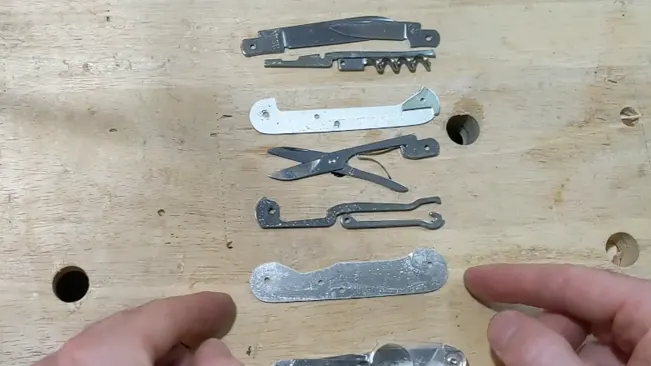
This step is particularly important for those who use their knives frequently in outdoor settings or for intricate tasks. By carefully taking apart the removable components, you can access and clean areas that would otherwise be unreachable, such as the inner workings of the hinges and the spaces between tools. Although it requires a bit of patience and attention to detail, this disassembly process plays a significant role in maintaining the overall functionality and longevity of the knife, ensuring that each tool can perform optimally and remain free from rust or debris accumulation.
Step 2. Washing

To effectively clean my Swiss Army Knife, I prepare a mixture of warm water and mild detergent, ensuring it’s gentle on the knife’s metal and plastic components. I then use a soft-bristled toothbrush, an ideal tool for this purpose, to meticulously scrub each part. The toothbrush allows me to access and clean hard-to-reach areas, particularly between the tools and around the pivot points, where dirt tends to accumulate. This method not only ensures thorough cleaning but also protects the knife from potential damage caused by abrasive materials, maintaining both its functionality and appearance. Regular cleaning in this manner is essential for prolonging the life and performance of the knife.
Step 3. Rinsing and Drying
After washing my Swiss Army Knife, I carefully rinse it to eliminate any soap residue, understanding that leftover soap can cause damage over time. I then thoroughly dry it with a lint-free cloth, paying special attention to areas like joints and tool interfaces where water is likely to accumulate.
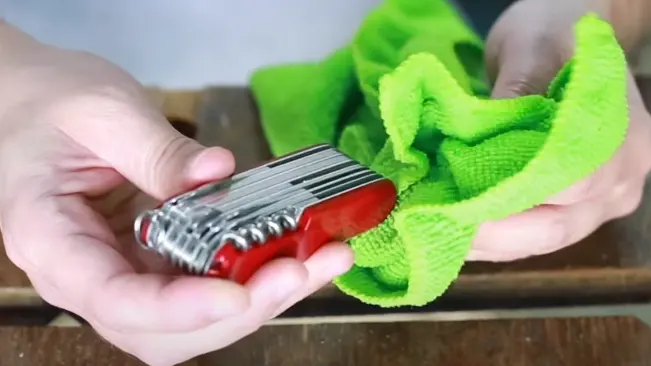
This step is essential to prevent rust and corrosion, particularly in the knife’s moving parts. To ensure it is completely moisture-free, I leave the knife open in a ventilated area for air drying, a practice that not only preserves its functionality but also significantly extends its lifespan. This thorough rinsing and drying routine is a critical part of my knife maintenance, safeguarding against potential damage and ensuring the knife remains in optimal condition.
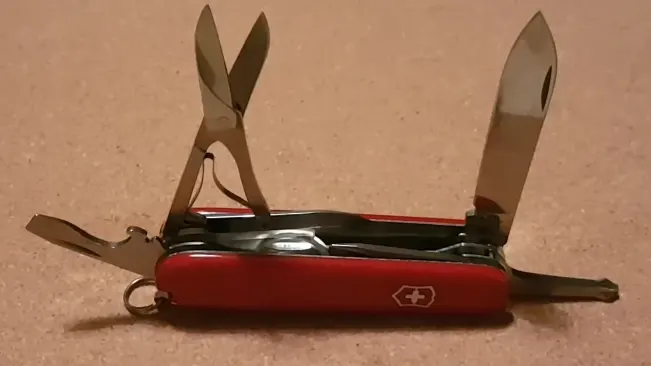
Step 4. Lubrication
Once my Swiss Army Knife is clean and dry, I move on to the vital step of lubrication. For this, I specifically use a mineral-based oil, which I find to be both effective and safe for the knife’s components. Applying this oil to each pivot point, I ensure that it reaches the inner workings where the tools rotate and fold.
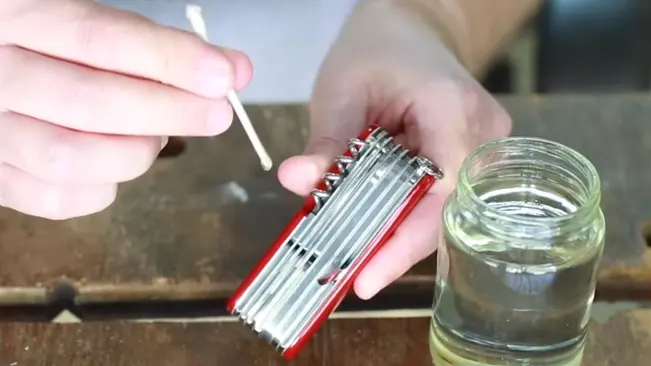
This lubrication is not just about easing the opening and closing of each tool; it plays a significant role in the knife’s maintenance. The oil forms a protective layer over the metal, shielding it from moisture and air, which are the primary causes of rust and corrosion. It also helps in reducing friction, which can wear down the joints over time. The right amount of lubrication is key too little won’t provide enough protection, while too much can attract dirt and debris. This balance is essential for maintaining the knife’s functionality and prolonging its lifespan, keeping it ready and reliable for any situation.
Comparing Cleaning Kits
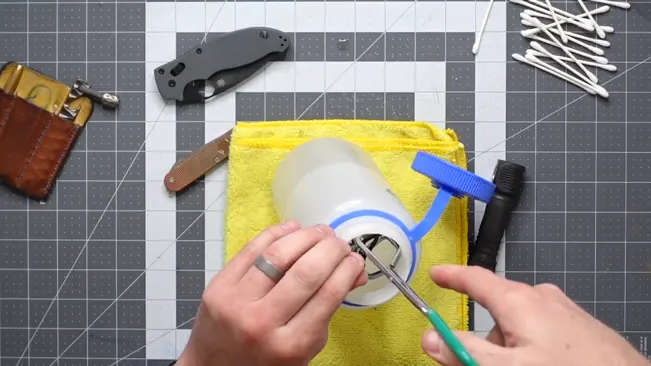
While there are various commercial cleaning kits available for Swiss Army Knives, I’ve discovered that a basic DIY approach is often equally effective. This method typically involves using household items like mild soap and a soft toothbrush. However, for those who prefer a ready-to-use kit, it’s important to choose one containing a non-abrasive cleaning solution, a gentle brush for scrubbing without scratching, and a high-quality lubricant to ensure smooth operation and protection against rust. This choice largely depends on personal preference and convenience.
Maintenance Tips
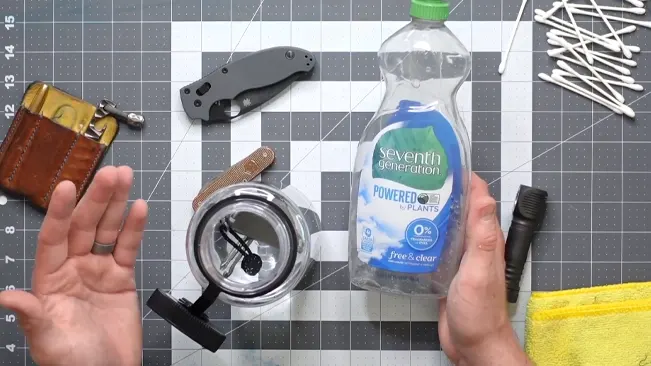
- Regular Cleaning Clean your knife after each use, especially after exposure to dirt, moisture, or salty environments.
- Use Mild Soap Opt for a mild detergent when cleaning to avoid damaging the metal and plastic parts.
- Soft Brush for Scrubbing Employ a soft toothbrush for cleaning hard-to-reach areas and removing stubborn dirt.
- Thorough Rinsing Rinse the knife well to remove any soap residue, which can corrode the metal over time.
- Complete Drying Dry the knife thoroughly with a lint-free cloth; residual moisture can cause rust.
- Lubrication is Key Post-cleaning, apply a mineral-based oil to pivot points for smooth operation and rust prevention.
- Regular Sharpening Keep the blades sharp for optimal performance, using a whetstone or appropriate sharpening tool.
- Check for Wear and Tear Periodically inspect your knife for any signs of damage or excessive wear.
- Store Properly Store your knife in a dry place to prevent moisture accumulation and rust.
- Avoid Misuse Use your Swiss Army Knife for its intended purposes only to maintain its condition and functionality.
Pros and Cons
Pros
- Enhanced Durability Regular maintenance prolongs the life of the knife, ensuring it lasts for years.
- Optimal Performance Keeping the knife clean, sharp, and well-lubricated ensures that each tool functions smoothly and effectively.
- Prevents Rust and Corrosion Thorough drying and proper lubrication protect the metal components from rust and corrosion.
- Safety A well-maintained knife is safer to use as sharp, clean blades reduce the risk of accidents caused by excessive force.
- Cost-Effective Regular upkeep avoids the need for frequent replacements, saving money in the long run.
- Preserved Aesthetics Regular cleaning maintains the knife’s appearance, keeping it looking new and polished.
Cons
- Time-Consuming Proper maintenance requires time and effort, which might be inconvenient for busy individuals.
- Requires Skill Certain maintenance tasks like sharpening the blade require a bit of skill and practice.
- Risk of Damage Incorrect disassembly or cleaning methods can potentially damage the knife.
- Need for Tools and Supplies You’ll need access to cleaning supplies and possibly sharpening tools, which is an additional investment.
- Regular Commitment To keep the knife in top condition, maintenance needs to be done regularly and consistently.
- Potential for Misassembly If disassembly is required, there’s a risk of reassembling the parts incorrectly.
My Verdict
Cleaning and maintaining a Swiss Army knife might seem like a chore, but it’s a necessary one. The benefits far outweigh the effort. My knife has stood the test of time and usage, thanks to the care I’ve put into cleaning and maintaining it.
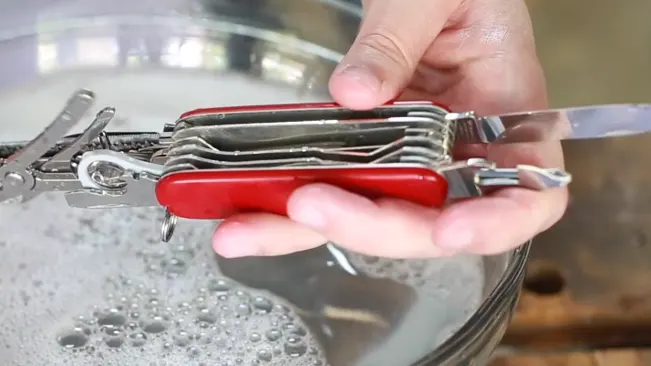
In conclusion, whether you’re an avid camper, a handy person, or just someone who appreciates the utility of a Swiss Army knife, keeping it clean is paramount. My experience has shown that a well-maintained knife not only performs better but also becomes a dependable tool in various situations. Remember, a clean Swiss Army knife is not just a tool, it’s a trusted companion in your adventures.
FAQs
- Can I clean my Swiss Army knife in a dishwasher?
No, it’s not recommended to clean your Swiss Army knife in a dishwasher. The high heat and harsh detergents can damage the knife’s components. Hand washing with mild soap and water is the safest method. - How often should I clean my Swiss Army knife?
The frequency of cleaning depends on usage. If you use it regularly, a monthly cleaning is ideal. However, if it’s exposed to dirt, sand, or saltwater, clean it immediately after use. - What kind of oil should I use for lubrication?
Use a mineral-based oil, such as multipurpose or machine oil. Avoid using cooking oils as they can become sticky and attract more dirt. - Can rust on a Swiss Army knife be removed?
Yes, rust can be removed using a mild abrasive like baking soda mixed with water. Apply the paste, scrub gently with a soft brush, and then rinse and dry thoroughly. - Is it safe to disassemble my Swiss Army knife for cleaning?
Disassembling your knife is not generally recommended unless you’re experienced in reassembling it correctly. Cleaning without disassembly is usually sufficient. - How do I sharpen the blades of my Swiss Army knife?
Use a whetstone or a knife sharpener designed for small blades. Sharpen at a 15-20 degree angle, maintaining consistent pressure and angle throughout the process. - What’s the best way to store my Swiss Army knife?
Store it in a dry place and, if possible, in a knife pouch or box. Avoid storing it in damp or humid environments to prevent rust. - Can I use WD-40 for lubricating my Swiss Army knife?
While WD-40 can be used for lubrication, it’s not the best option as it’s more of a cleaner and rust remover. A dedicated lubricating oil is preferable. - How can I clean the scales (handles) of my Swiss Army knife?
Clean the scales with a damp cloth and mild soap. Avoid submerging the knife in water as it can seep into the inner mechanisms. - What should I do if my Swiss Army knife tools are hard to open?
Apply a drop of lubricating oil at the base of each tool and work them back and forth until they move smoothly. If the problem persists, consider a thorough cleaning.

Jack Williams
As the founder and chief reviewer at KnifeCritic, my extensive experience in professional kitchens has honed my expertise in boning and fillet knives, making me a trusted authority in the culinary tool industry. KnifeCritic was born out of a passion for empowering both professional chefs and home cooks with in-depth, reliable reviews and insights into the world of specialized kitchen knives. Our platform is dedicated to demystifying the selection and maintenance of culinary tools, ensuring that high-quality knives are accessible to everyone passionate about cooking. Through KnifeCritic, I strive to enhance the cooking experience by providing valuable information that elevates the preparation and final presentation of dishes.

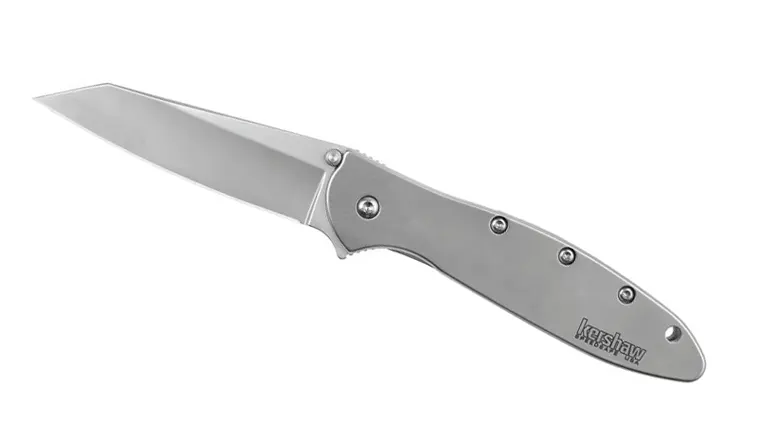

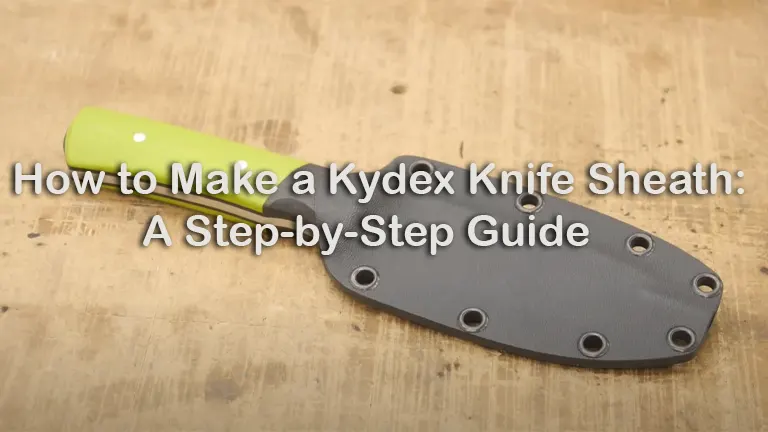
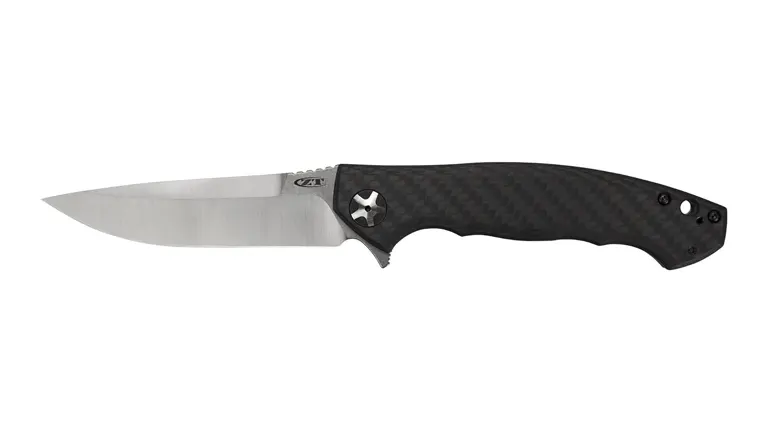


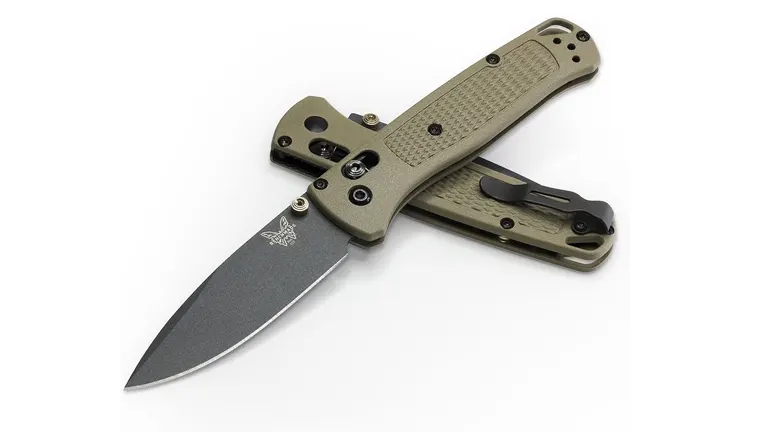
Leave your comment